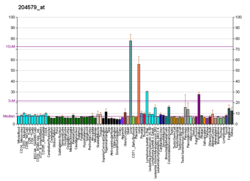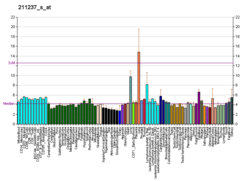Fibroblast growth factor receptor 4
Fibroblast growth factor receptor 4 is a protein that in humans is encoded by the FGFR4 gene. FGFR4 has also been designated as CD334 (cluster of differentiation 334).
The protein encoded by this gene is a member of the fibroblast growth factor receptor family, where amino acid sequence is highly conserved between members and throughout evolution. FGFR family members differ from one another in their ligand affinities and tissue distribution. A full-length representative protein would consist of an extracellular region, composed of three immunoglobulin-like domains, a single hydrophobic membrane-spanning segment and a cytoplasmic tyrosine kinase domain. The extracellular portion of the protein interacts with fibroblast growth factors, setting in motion a cascade of downstream signals, ultimately influencing mitogenesis and differentiation. The genomic organization of this gene, compared to members 1-3, encompasses 18 exons rather than 19 or 20. Although alternative splicing has been observed, there is no evidence that the C-terminal half of the IgIII domain of this protein varies between three alternate forms, as indicated for members 1-3. This particular family member preferentially binds acidic fibroblast growth factor and, although its specific function is unknown, it is overexpressed in gynecological tumor samples, suggesting a role in breast and ovarian tumorigenesis.[5] In a meta-analisis study, the functional polymorphism Gly388Arg (rs351855) of FGFR4 was observed to be significantly associated with nodal involvement and overall survival in patients with different types of cancer. [6]
Interactions
Fibroblast growth factor receptor 4 has been shown to interact with FGF1.[7][8]
References
- GRCh38: Ensembl release 89: ENSG00000160867 - Ensembl, May 2017
- GRCm38: Ensembl release 89: ENSMUSG00000005320 - Ensembl, May 2017
- "Human PubMed Reference:". National Center for Biotechnology Information, U.S. National Library of Medicine.
- "Mouse PubMed Reference:". National Center for Biotechnology Information, U.S. National Library of Medicine.
- "Entrez Gene: FGFR4 fibroblast growth factor receptor 4".
- Frullanti, E (2011). "Meta and pooled analyses of FGFR4 Gly388Arg polymorphism as a cancer prognostic factor". Eur J Cancer Prev. 20 (4): 340–347. doi:10.1097/CEJ.0b013e3283457274. PMID 21412156.
- Loo, B B; Darwish K K; Vainikka S S; Saarikettu J J; Vihko P P; Hermonen J J; Goldman A A; Alitalo K K; Jalkanen M M (May 2000). "Production and characterization of the extracellular domain of recombinant human fibroblast growth factor receptor 4". Int. J. Biochem. Cell Biol. ENGLAND. 32 (5): 489–97. doi:10.1016/S1357-2725(99)00145-4. ISSN 1357-2725. PMID 10736564.
- Kan, M; Wu X; Wang F; McKeehan W L (May 1999). "Specificity for fibroblast growth factors determined by heparan sulfate in a binary complex with the receptor kinase". J. Biol. Chem. UNITED STATES. 274 (22): 15947–52. doi:10.1074/jbc.274.22.15947. ISSN 0021-9258. PMID 10336501.
Further reading
- Doherty P, Smith P, Walsh FS (1997). "Shared cell adhesion molecule (CAM) homology domains point to CAMs signalling via FGF receptors". Perspectives on developmental neurobiology. 4 (2–3): 157–68. PMID 9168198.
- Warrington JA, Bailey SK, Armstrong E, et al. (1992). "A radiation hybrid map of 18 growth factor, growth factor receptor, hormone receptor, or neurotransmitter receptor genes on the distal region of the long arm of chromosome 5". Genomics. 13 (3): 803–8. doi:10.1016/0888-7543(92)90156-M. PMID 1322355.
- Armstrong E, Partanen J, Cannizzaro L, et al. (1992). "Localization of the fibroblast growth factor receptor-4 gene to chromosome region 5q33-qter". Genes Chromosomes Cancer. 4 (1): 94–8. doi:10.1002/gcc.2870040116. PMID 1377018.
- Vainikka S, Partanen J, Bellosta P, et al. (1992). "Fibroblast growth factor receptor-4 shows novel features in genomic structure, ligand binding and signal transduction". EMBO J. 11 (12): 4273–80. PMC 557000. PMID 1385111.
- Partanen J, Mäkelä TP, Eerola E, et al. (1991). "FGFR-4, a novel acidic fibroblast growth factor receptor with a distinct expression pattern". EMBO J. 10 (6): 1347–54. doi:10.1002/j.1460-2075.1991.tb07654.x. PMC 452793. PMID 1709094.
- Holtrich U, Bräuninger A, Strebhardt K, Rübsamen-Waigmann H (1992). "Two additional protein-tyrosine kinases expressed in human lung: fourth member of the fibroblast growth factor receptor family and an intracellular protein-tyrosine kinase". Proc. Natl. Acad. Sci. U.S.A. 88 (23): 10411–5. Bibcode:1991PNAS...8810411H. doi:10.1073/pnas.88.23.10411. PMC 52938. PMID 1720539.
- Partanen J, Mäkelä TP, Alitalo R, et al. (1991). "Putative tyrosine kinases expressed in K-562 human leukemia cells". Proc. Natl. Acad. Sci. U.S.A. 87 (22): 8913–7. Bibcode:1990PNAS...87.8913P. doi:10.1073/pnas.87.22.8913. PMC 55070. PMID 2247464.
- Vainikka S, Joukov V, Wennström S, et al. (1994). "Signal transduction by fibroblast growth factor receptor-4 (FGFR-4). Comparison with FGFR-1". J. Biol. Chem. 269 (28): 18320–6. PMID 7518429.
- Wen Z, Zhong Z, Darnell JE (1995). "Maximal activation of transcription by Stat1 and Stat3 requires both tyrosine and serine phosphorylation". Cell. 82 (2): 241–50. doi:10.1016/0092-8674(95)90311-9. PMID 7543024.
- Quelle FW, Thierfelder W, Witthuhn BA, et al. (1995). "Phosphorylation and activation of the DNA binding activity of purified Stat1 by the Janus protein-tyrosine kinases and the epidermal growth factor receptor". J. Biol. Chem. 270 (35): 20775–80. doi:10.1074/jbc.270.35.20775. PMID 7657660.
- Ron D, Reich R, Chedid M, et al. (1993). "Fibroblast growth factor receptor 4 is a high affinity receptor for both acidic and basic fibroblast growth factor but not for keratinocyte growth factor". J. Biol. Chem. 268 (8): 5388–94. PMID 7680645.
- Shuai K, Stark GR, Kerr IM, Darnell JE (1993). "A single phosphotyrosine residue of Stat91 required for gene activation by interferon-gamma". Science. 261 (5129): 1744–6. Bibcode:1993Sci...261.1744S. doi:10.1126/science.7690989. PMID 7690989.
- Jaakkola S, Salmikangas P, Nylund S, et al. (1993). "Amplification of fgfr4 gene in human breast and gynecological cancers". Int. J. Cancer. 54 (3): 378–82. doi:10.1002/ijc.2910540305. PMID 8099571.
- Maruyama K, Sugano S (1994). "Oligo-capping: a simple method to replace the cap structure of eukaryotic mRNAs with oligoribonucleotides". Gene. 138 (1–2): 171–4. doi:10.1016/0378-1119(94)90802-8. PMID 8125298.
- Reich-Slotky R, Shaoul E, Berman B, et al. (1996). "Chimeric molecules between keratinocyte growth factor and basic fibroblast growth factor define domains that confer receptor binding specificities". J. Biol. Chem. 270 (50): 29813–8. doi:10.1074/jbc.270.50.29813. PMID 8530375.
- Vainikka S, Joukov V, Klint P, Alitalo K (1996). "Association of a 85-kDa serine kinase with activated fibroblast growth factor receptor-4". J. Biol. Chem. 271 (3): 1270–3. doi:10.1074/jbc.271.3.1270. PMID 8576110.
- Kaptein A, Paillard V, Saunders M (1996). "Dominant negative stat3 mutant inhibits interleukin-6-induced Jak-STAT signal transduction". J. Biol. Chem. 271 (11): 5961–4. doi:10.1074/jbc.271.11.5961. PMID 8626374.
- Ornitz DM, Xu J, Colvin JS, et al. (1996). "Receptor specificity of the fibroblast growth factor family". J. Biol. Chem. 271 (25): 15292–7. doi:10.1074/jbc.271.25.15292. PMID 8663044.
- Agnès F, Toux MM, André C, Galibert F (1997). "Genomic organization of the extracellular coding region of the human FGFR4 and FLT4 genes: evolution of the genes encoding receptor tyrosine kinases with immunoglobulin-like domains". J. Mol. Evol. 45 (1): 43–9. Bibcode:1997JMolE..45...43A. doi:10.1007/PL00006199. PMID 9211733.
External links
- FGFR4+protein,+human at the US National Library of Medicine Medical Subject Headings (MeSH)
This article incorporates text from the United States National Library of Medicine, which is in the public domain.





